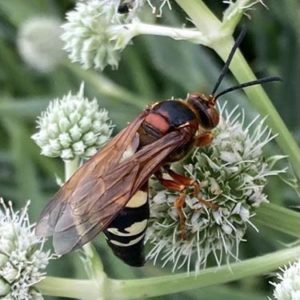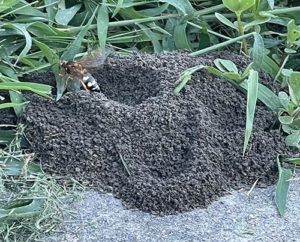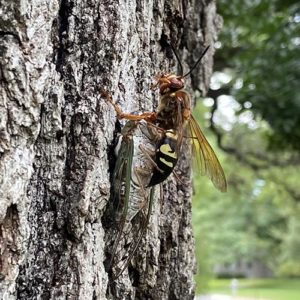Every summer, about the time that the annual cicadas start calling, one of our largest wasps appears. They can be kind of intimidating because of their size. Their yellow, black, and reddish-brown coloration only adds to their menacing look. These wasps are called cicada killers, and unless you are a cicada, you really don’t have anything to worry about from them. Instead, they are interesting insects that play an important role in controlling cicada populations and provide food for birds.

What is a cicada killer?
Cicada killers are large, solitary wasps that are active in the mid to late summer. They are among our largest wasps. Cicada killers get their name from the only food they feed their young – cicadas. There are four species of cicada killers in North America.
The eastern cicada killer (Sphecius speciosus) is the only one found in the eastern U.S., so we tend to drop the “eastern” part of their name and just call them cicada killers. I’m going to do that here too. If you live west of the Mississippi River, then you may have a different species and the details about your species may be slightly different. Our eastern cicada killers can range in size from 0.6 to 2 inches long, with females being larger than males.
Will cicada killers hurt me, my children, or pets?
Despite looking big and intimidating, cicada killers pose little to no threat to humans or our pets.
The males are the ones that are most likely to fly up to us. Basically, they are just checking us out to make sure we aren’t another cicada killer. (That’s the same thing the male carpenter bees are doing when they hover in front of us earlier in the season.) Male cicada killers don’t have stingers, and thus pose zero threat to us or our loved ones.
The females do have a stinger, but very, very rarely use it against people or pets. They are too busy digging their nesting burrow, capturing one or more cicadas for every egg they lay, dragging those cicadas back to their nesting burrows, and just generally going about their lives. For the most part, they would rather fly away from a perceived threat than attack and risk getting injured or killed. In order to get stung, you would most likely have to catch or trap the female cicada killer so that it felt like it had no other option to get away.
What do they eat?
The adults will visit flowers to drink nectar. The larvae eat the cicadas that their mother puts in their egg chambers.
Life history
Adult Males
The adult males emerge from their underground burrows before the females emerge. This usually occurs around June or July – about the same time as the annual cicadas start to appear. Each male will try to establish a territory in the general vicinity of where it emerged.
If multiple males emerge in the same area, then they may fight for the territory. Fights consist of in-air wrestling matches where each male tries to get on the back of the other male. The fights will continue until one of the males gives up and flies off. If anything (including you) enters a male’s territory, it will quickly fly up to see if the “intruder” is a cicada killer.
Adult Females

The adult females emerge from their underground burrows shortly after the males. Their first order of business is to mate. The female will then fly off to find a suitable place to dig her nesting tunnel. She is solely responsible for digging her own nesting tunnel, provisioning it, and laying her eggs. Neither the male, nor any other females, will assist her.
Cicada killers prefer to dig nesting tunnels in areas with dry, loose soil and little vegetation. The female uses her jaws and front legs to loosen the dirt and pushes it out with specialized spikes on her back legs. She may also turn around and push mounds of dirt out with her head and front legs. Her nesting tunnel can be several feet long and have multiple egg chambers branching off the main tunnel. The soil removed from the tunnel and egg chambers is often piled around the entrance and can be one of the most obvious ways to locate a nesting tunnel.
After creating a nesting tunnel, the female cicada killer hunts for cicadas. She appears to hunt primarily by sight and will often attack cicadas in flight. The impact of the female cicada killer colliding with the cicada can produce an audible “whack” if you are lucky enough to be around when a cicada killer catches a cicada in flight. It really is pretty impressive. When she attacks a cicada, she grabs and stings it. The venom she injects into the cicada paralyzes the insect, but does not kill it. She then carries the cicada back to her burrow.
The cicada she captures can weigh up to twice as much as the cicada killer. If she captures the cicada close to the ground, she may drag it all the way to her nest if the nest is close or she may drag the cicada up a tree or other object before taking flight with it so she doesn’t have to lift it off the ground.
Once back at her nesting tunnel, the female cicada killer will drag the paralyzed cicada into the tunnel and into an awaiting egg chamber in the nesting tunnel. Each of her young will get its own “room” or egg chamber within the nesting tunnel.
Female cicada killers choose the sex of their offspring by deciding whether or not to fertilize each egg that they lay. Fertilized eggs will develop into females, while unfertilized eggs will develop into males. If she is going to lay an unfertilized egg, then she will only put one cicada into the egg chamber before laying an egg on the cicada and sealing the chamber. However, if the egg will develop into a female, then two or three cicadas will be put in the egg chamber before the egg is laid. The female eggs are given more food because they will develop into larger adults.
Both the adult males and the adult females will die before winter.

Young
The eggs hatch a few days after they are laid. The larva that emerges will feed on the paralyzed cicada(s) that are in the egg chamber with it. After a week and a half to two weeks, the larva will have consumed all of the food in its chamber leaving nothing but the cicada’s exoskeleton. The larva will then spin a cocoon and go into the insect form of hibernation until the following spring when it will pupate before emerging as an adult in the summer.
Role in the ecosystem
As predators, cicada killers help keep cicada populations in check. Cicada killers are also prey and songbirds may catch and eat them.
What to do if you have cicada killers nesting in your yard
In my opinion, your best course of action if you have cicada killers nesting in your yard is not to worry about them. They aren’t likely to cause any harm to you, your loved ones, or your yard. They will also help keep your cicada population in check and provide food for the songbirds in your area.
If you can’t stand the idea of having them nest in your yard, then your best course of action is to create an environment that the cicada killers don’t like. That means keeping the ground moist and making sure you have a thick, vegetative groundcover that they don’t want to dig through. Spraying cicada killers isn’t a long-term solution because the adults will die in the fall anyway and the if area is attracting cicada killers this year, then it will likely attract new cicada killers next year.
Summary
Although cicada killers can be intimidating because of their large size, they pose relatively little threat to people. The males don’t have a stinger and therefore are incapable of stinging. While female cicada killers can sting a person, they rarely do so. They are too busy digging nesting tunnels, capturing cicadas, and laying eggs to defend their nesting sites. In the end, they are a very interesting creature that plays a valuable role in the ecosystem by helping to control cicada populations and as potential prey for many of our insectivorous birds.

Backyard Ecology: Exploring Nature in Your Backyard
Nature isn’t just “out there.” It’s all around us, including right outside our doors. Hi, my name is Shannon Trimboli, and I am the host of Backyard Ecology. I live in southcentral Kentucky and am a wildlife biologist, educator, author, beekeeper, and owner of a nursery specializing in plants for pollinators and wildlife conservation. I invite you to join me as we ignite our curiosity and natural wonder, explore our yards and communities, and improve our local pollinator and wildlife habitat. Learn more or subscribe to my email list at www.backyardecology.net.

Leave a Reply